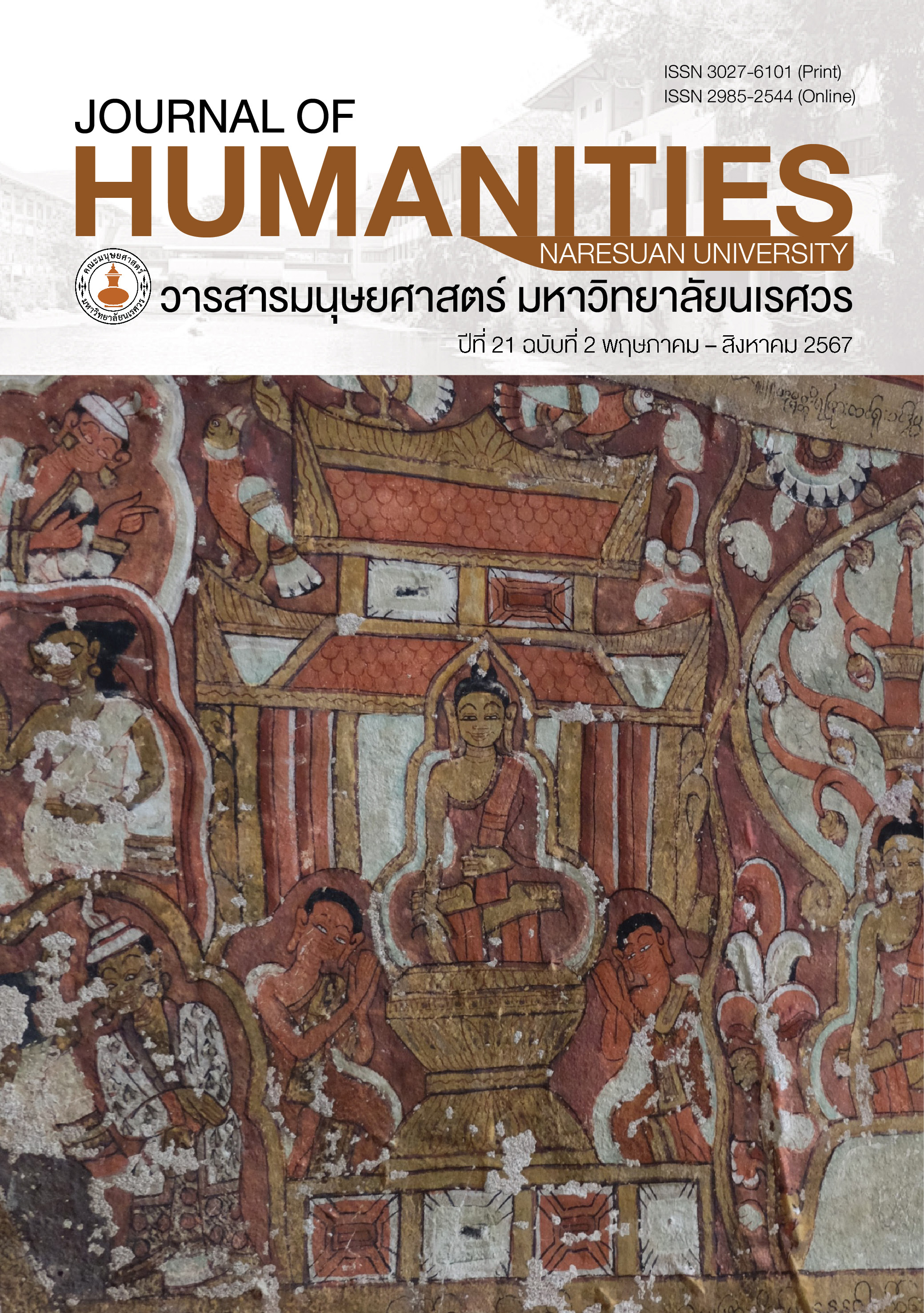ประโยคประธานไร้ตัวตน: หน้าที่และการเข้าใจข้ามภาษาผ่านภาษาศาสตร์และการแปลจากอังกฤษเป็นไทย
Main Article Content
บทคัดย่อ
บทความวิจัยนี้เป็นการศึกษาหน้าที่และการเข้าใจข้ามภาษาเกี่ยวกับประโยคประธานไร้ตัวตนผ่านภาษาศาสตร์และการแปลจากภาษาอังกฤษสู่ภาษาไทย โดยมีข้อมูลวิจัยเป็นตัวบทประเภทเรื่องเล่า มีแนวทางการวิเคราะห์ด้านภาษาศาสตร์บนพื้นฐานไวยากรณ์หน้าที่นิยมเชิงแบบลักษณ์และด้านการแปลในแนวสากลของ Newmark ผลการวิจัยปรากฏว่าประโยคประเภทนี้ มีการแปลเป็นภาษาไทยใน 3 กลุ่มวิธีได้แก่การแปลแบบตามอักษร ปรากฏร้อยละ 57 จากจำนวนประโยคทั้งหมด การแปลแบบไม่ตามอักษร ร้อยละ 42 ซึ่งรวมวิธีการแปลแบบตรงภาษา แบบตรงความหมาย และแบบสื่อความ และการไม่แปล ร้อยละ 1 ในส่วนของหน้าที่ปรากฏในเชิงสื่อสารและเชิงไวยากรณ์ หน้าที่เชิงสื่อสารปรากฏในระดับประโยคและระดับสัมพันธสาร ในระดับประโยคแสดงสภาพอากาศ อุณหภูมิ สภาพแวดล้อม สถานการณ์ เวลา ระยะทาง การระบุบุคคล ความเกี่ยวข้อง และสาเหตุ ส่วนในระดับสัมพันธสารแสดงการเจาะเน้นต่าง สำหรับหน้าที่เชิงไวยากรณ์แสดงประโยคประธานเปลี่ยนตำแหน่ง ซึ่งใช้แทนประโยคที่มีกริยารับประธานเชิงประโยคในภาษาพูด ส่วนใหญ่ผู้แปลมีความเข้าใจถึงหน้าที่และโครงสร้างภาษา มีเพียงการแปลหน้าที่การเจาะเน้นต่างเท่านั้นที่ผู้แปลไม่ได้คงไว้ซึ่งสารเดิมในบางโอกาส
Article Details

อนุญาตภายใต้เงื่อนไข Creative Commons Attribution-NonCommercial-NoDerivatives 4.0 International License.
ข้อความรู้ใด ๆ ตลอดจนข้อคิดเห็นใด ๆ เป็นของผู้เขียนแต่ละท่านโดยเฉพาะ คณะมนุษยศาสตร์ มหาวิทยาลัยนเรศวร และกองบรรณาธิการวารสารมนุษยศาสตร์ฯ ไม่จำเป็นต้องเห็นพ้องด้วย
เอกสารอ้างอิง
กุลธิดา สืบหล้า. (2548). ย่านเก่า มุมเมือง และเรื่องเล่า. กรุงเทพฯ: สร้างสรรค์บุ๊คส์.
จินณวัฒน์ แก่นเมือง. (2565). การเปลี่ยนแปลงความหมายเชิงการอ้างถึงของสรรพนาม “มัน” ในภาษาไทย. วารสารวจนะ, 10(1), 28-58.
โจแอน ดิดิออง. (2549). ปีแห่งความคิดสุดวิเศษ [The Year of Magical Thinking] (ภาสกร ประมูลวงศ์, ผู้แปล). กรุงเทพฯ: มติชน. (ต้นฉบับพิมพ์ปี พ.ศ. 2548).
ฝ่ายวิชาการสำนักพิมพ์. (2562). ฝึกฝนทบทวนภาษาอังกฤษกับ 108 นิทานอีสป 2 ภาษา. กรุงเทพฯ: เก็ท ไอเดีย.
ราชบัณฑิตยสถาน. (2556). พจนานุกรมฉบับราชบัณฑิตยสถาน พ.ศ. 2554 เฉลิมพระเกียรติพระบาทสมเด็จพระเจ้าอยู่หัว เนื่องในโอกาสพระราชพิธีมหามงคลเฉลิมพระชนมพรรษา 7 รอบ 5 ธันวาคม 2554. กรุงเทพฯ: นานมีบุ๊คส์.
โรอันด์ ดาห์ล. (2562). มาทิลดา: นักอ่านสุดวิเศษ [Matilda]. (สาลินี คำฉันท์, ผู้แปล). กรุงเทพฯ: ผีเสื้อ. (ต้นฉบับพิมพ์ปี พ.ศ. 2531).
สมทรง บุรุษพัฒน์. (2532). ภาษาไทย: ภาษาเน้นเรื่อง. วารสารภาษาและวัฒนธรรม, 8(1), 11-17.
อมร เชิงรุ่งโรจน์. (2565). ต้นอมร: นิทานภาษาอังกฤษ. สืบค้นจาก https://www.tonamorn.com/english/story/
อัญชลี สิงห์น้อย วงศ์วัฒนา. (2560). หน้าที่ในการสื่อสารและวากยสัมพันธ์ของประโยคแปรในภาษาไทย: กรณีหน่วยสร้างประโยคหัวเรื่องเด่น. วารสารมนุษยศาสตร์, 14(4), 15-34.
อัญชลี สิงห์น้อย วงศ์วัฒนา. (2565). ไวยากรณ์ไทยเชิงสื่อสาร: การวิเคราะห์แนวภาษาศาสตร์หน้าที่นิยมเชิงแบบลักษณ์. พิษณุโลก: สำนักพิมพ์มหาวิทยาลัยนเรศวร.
Bolinger, D. (1977). The form of language. London: Longmans.
Celce-Murcia, M., & Larsen-Freeman, D. (1999). The grammar book: An ESL/EFL teacher’s course (2nd ed.). Boston, MA: Heinle and Heinle.
Chutisilp, P. (1984). A sociolinguistic study of an additional language: English in Thailand (Unpublished doctoral dissertation). Illinois: University of Illinois.
Dahl, R. (1988). Matilda. Pennsylvania: Penguin Group.
DailyEnglish. (2022). Ruam nithan phasa angkrit phrom kham plae thai [Collection of English tales with Thai translation]. Retrieved from https://www.dailyenglish.in.th/english-fables/
Didion, J. (2005). The year of magical thinking. New York: Vintage International.
Givón, T. (2001). Syntax I: An introduction volume I. Amsterdam/Philadelphia: John Benjamins Publishing.
Hoonchamlong, Y. (1991). Some issues in Thai anaphora: A government and binding approach (Unpublished doctoral dissertation). Wisconsin: University of Wisconsin-Madison.
Indrambarya, K. (1994). Subcategorization of verbs in Thai: A lexicase dependency approach (Unpublished doctoral dissertation). Hawai’i: University of Hawai'i at Manoa.
Indrambarya, K. (2011, May). On the non-referential subject /man/ in Thai. Paper presented at the 21st Annual Conference of Southeast Asian Linguistics Society, Kasetsart University, Bangkok, Thailand.
Indrambarya, K. (2012, June). On impersonal subjects in Thai. Paper presented at the 22nd Annual Conference of Southeast Asian Linguistics Society, Agay, France.
Indrambarya, K. (2015). Thai impersonal pronouns and language power. MANUSYA: Journal of Humanities, 21(special issue), 14-28.
Iwasaki, S., & Ingkaphirom, P. (2005). A reference grammar of Thai. Cambridge: Cambridge University Press.
Langacker, R. W. (1991). Foundations of cognitive grammar vol. II: Descriptive application. California: Stanford University Press.
Langhub. (2016). Khaw phasa angkrit phrom kham plae [English news with translation]. Retrieved from http://thai.langhub.com/th-en/learn-english-with-news
Li, C. N., & Thompson, S. A. (1976). Subject and topic: A new typology of language. In Subject and topic (pp. 459-489). New York: Academic Press.
Newmark, P. (1988). A textbook of translation. New York: Prentice Hall.
Nitanstory. (2017). Nithan phasa angkrit [English tales]. Retrieved from https://nitanstory.com/tale/englishfables/
Phimsawat, O. (2011). The syntax of pro-drop in Thai (Doctoral Dissertation). New Castle: New Castle University.
Prasithrathsint, A. (1997). The emergence and development of abstract nominalization in standard Thai. In A.S. Abramson (Ed.), Southeast Asian Linguistics Studies in Honor of Vichin Panupong (179-190). Bangkok: Chulalongkorn University Press.
Wongwattana, U. S. (2015). Complexities of Thai copular constructions. Journal of Southeast Asian Linguistics Society, 8, 97-120.


